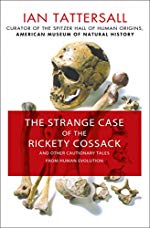The Strange Case of the Rickety Cossack
June 11, 2019 8:04 PM - by Ian Tattersall - Subscribe
n his new book The Strange Case of the Rickety Cossack, human paleoanthropologist Ian Tattersall argues that a long tradition of "human exceptionalism" in paleoanthropology has distorted the picture of human evolution. Drawing partly on his own career—from young scientist in awe of his elders to crotchety elder statesman—Tattersall offers an idiosyncratic look at the competitive world of paleoanthropology, beginning with Charles Darwin 150 years ago, and continuing through the Leakey dynasty in Africa, and concluding with the latest astonishing findings in the Caucasus.
The book's title refers to the 1856 discovery of a clearly very old skull cap in Germany's Neander Valley. The possessor had a brain as large as a modern human, but a heavy low braincase with a prominent brow ridge. Scientists tried hard to explain away the inconvenient possibility that this was not actually our direct relative. One extreme interpretation suggested that the preserved leg bones were curved by both rickets, and by a life on horseback. The pain of the unfortunate individual's affliction had caused him to chronically furrow his brow in agony, leading to the excessive development of bone above the eye sockets.
The subsequent history of human evolutionary studies is full of similarly fanciful interpretations. With tact and humor, Tattersall concludes that we are not the perfected products of natural processes, but instead the result of substantial doses of random happenstance.
The book's title refers to the 1856 discovery of a clearly very old skull cap in Germany's Neander Valley. The possessor had a brain as large as a modern human, but a heavy low braincase with a prominent brow ridge. Scientists tried hard to explain away the inconvenient possibility that this was not actually our direct relative. One extreme interpretation suggested that the preserved leg bones were curved by both rickets, and by a life on horseback. The pain of the unfortunate individual's affliction had caused him to chronically furrow his brow in agony, leading to the excessive development of bone above the eye sockets.
The subsequent history of human evolutionary studies is full of similarly fanciful interpretations. With tact and humor, Tattersall concludes that we are not the perfected products of natural processes, but instead the result of substantial doses of random happenstance.
I took a paleo-anthropology class at NYU in the late nineties. The professor mercilessly and repeatedly mocked the idea that homo sapiens had ever interbred with neanderthals. This was described as both physically and genetically impossible. It was a great class, but this particular observation did not age well... I remain very interested in this stuff.
posted by xammerboy at 8:01 PM on June 12, 2019 [1 favorite]
posted by xammerboy at 8:01 PM on June 12, 2019 [1 favorite]
You are not logged in, either login or create an account to post comments

posted by Homo neanderthalensis at 8:08 PM on June 11, 2019 [1 favorite]